Input interpretation

KCl (potassium chloride) + AgNO_3 (silver nitrate) ⟶ KNO_3 (potassium nitrate) + AgCl (silver chloride)
Balanced equation
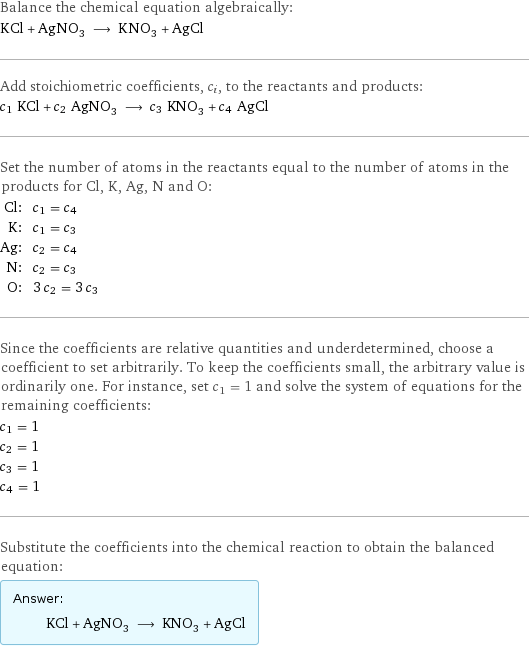
Balance the chemical equation algebraically: KCl + AgNO_3 ⟶ KNO_3 + AgCl Add stoichiometric coefficients, c_i, to the reactants and products: c_1 KCl + c_2 AgNO_3 ⟶ c_3 KNO_3 + c_4 AgCl Set the number of atoms in the reactants equal to the number of atoms in the products for Cl, K, Ag, N and O: Cl: | c_1 = c_4 K: | c_1 = c_3 Ag: | c_2 = c_4 N: | c_2 = c_3 O: | 3 c_2 = 3 c_3 Since the coefficients are relative quantities and underdetermined, choose a coefficient to set arbitrarily. To keep the coefficients small, the arbitrary value is ordinarily one. For instance, set c_1 = 1 and solve the system of equations for the remaining coefficients: c_1 = 1 c_2 = 1 c_3 = 1 c_4 = 1 Substitute the coefficients into the chemical reaction to obtain the balanced equation: Answer: | | KCl + AgNO_3 ⟶ KNO_3 + AgCl
Structures
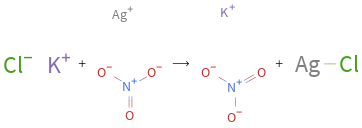
+ ⟶ +
Names

potassium chloride + silver nitrate ⟶ potassium nitrate + silver chloride
Reaction thermodynamics
Enthalpy
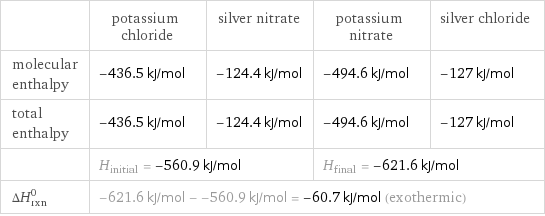
| potassium chloride | silver nitrate | potassium nitrate | silver chloride molecular enthalpy | -436.5 kJ/mol | -124.4 kJ/mol | -494.6 kJ/mol | -127 kJ/mol total enthalpy | -436.5 kJ/mol | -124.4 kJ/mol | -494.6 kJ/mol | -127 kJ/mol | H_initial = -560.9 kJ/mol | | H_final = -621.6 kJ/mol | ΔH_rxn^0 | -621.6 kJ/mol - -560.9 kJ/mol = -60.7 kJ/mol (exothermic) | | |
Gibbs free energy
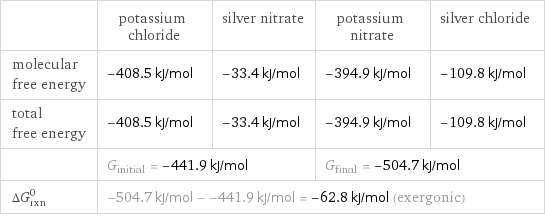
| potassium chloride | silver nitrate | potassium nitrate | silver chloride molecular free energy | -408.5 kJ/mol | -33.4 kJ/mol | -394.9 kJ/mol | -109.8 kJ/mol total free energy | -408.5 kJ/mol | -33.4 kJ/mol | -394.9 kJ/mol | -109.8 kJ/mol | G_initial = -441.9 kJ/mol | | G_final = -504.7 kJ/mol | ΔG_rxn^0 | -504.7 kJ/mol - -441.9 kJ/mol = -62.8 kJ/mol (exergonic) | | |
Equilibrium constant
![Construct the equilibrium constant, K, expression for: KCl + AgNO_3 ⟶ KNO_3 + AgCl Plan: • Balance the chemical equation. • Determine the stoichiometric numbers. • Assemble the activity expression for each chemical species. • Use the activity expressions to build the equilibrium constant expression. Write the balanced chemical equation: KCl + AgNO_3 ⟶ KNO_3 + AgCl Assign stoichiometric numbers, ν_i, using the stoichiometric coefficients, c_i, from the balanced chemical equation in the following manner: ν_i = -c_i for reactants and ν_i = c_i for products: chemical species | c_i | ν_i KCl | 1 | -1 AgNO_3 | 1 | -1 KNO_3 | 1 | 1 AgCl | 1 | 1 Assemble the activity expressions accounting for the state of matter and ν_i: chemical species | c_i | ν_i | activity expression KCl | 1 | -1 | ([KCl])^(-1) AgNO_3 | 1 | -1 | ([AgNO3])^(-1) KNO_3 | 1 | 1 | [KNO3] AgCl | 1 | 1 | [AgCl] The equilibrium constant symbol in the concentration basis is: K_c Mulitply the activity expressions to arrive at the K_c expression: Answer: | | K_c = ([KCl])^(-1) ([AgNO3])^(-1) [KNO3] [AgCl] = ([KNO3] [AgCl])/([KCl] [AgNO3])](../image_source/1bbf2526acf02f8601b69858c6962ce3.png)
Construct the equilibrium constant, K, expression for: KCl + AgNO_3 ⟶ KNO_3 + AgCl Plan: • Balance the chemical equation. • Determine the stoichiometric numbers. • Assemble the activity expression for each chemical species. • Use the activity expressions to build the equilibrium constant expression. Write the balanced chemical equation: KCl + AgNO_3 ⟶ KNO_3 + AgCl Assign stoichiometric numbers, ν_i, using the stoichiometric coefficients, c_i, from the balanced chemical equation in the following manner: ν_i = -c_i for reactants and ν_i = c_i for products: chemical species | c_i | ν_i KCl | 1 | -1 AgNO_3 | 1 | -1 KNO_3 | 1 | 1 AgCl | 1 | 1 Assemble the activity expressions accounting for the state of matter and ν_i: chemical species | c_i | ν_i | activity expression KCl | 1 | -1 | ([KCl])^(-1) AgNO_3 | 1 | -1 | ([AgNO3])^(-1) KNO_3 | 1 | 1 | [KNO3] AgCl | 1 | 1 | [AgCl] The equilibrium constant symbol in the concentration basis is: K_c Mulitply the activity expressions to arrive at the K_c expression: Answer: | | K_c = ([KCl])^(-1) ([AgNO3])^(-1) [KNO3] [AgCl] = ([KNO3] [AgCl])/([KCl] [AgNO3])
Rate of reaction
![Construct the rate of reaction expression for: KCl + AgNO_3 ⟶ KNO_3 + AgCl Plan: • Balance the chemical equation. • Determine the stoichiometric numbers. • Assemble the rate term for each chemical species. • Write the rate of reaction expression. Write the balanced chemical equation: KCl + AgNO_3 ⟶ KNO_3 + AgCl Assign stoichiometric numbers, ν_i, using the stoichiometric coefficients, c_i, from the balanced chemical equation in the following manner: ν_i = -c_i for reactants and ν_i = c_i for products: chemical species | c_i | ν_i KCl | 1 | -1 AgNO_3 | 1 | -1 KNO_3 | 1 | 1 AgCl | 1 | 1 The rate term for each chemical species, B_i, is 1/ν_i(Δ[B_i])/(Δt) where [B_i] is the amount concentration and t is time: chemical species | c_i | ν_i | rate term KCl | 1 | -1 | -(Δ[KCl])/(Δt) AgNO_3 | 1 | -1 | -(Δ[AgNO3])/(Δt) KNO_3 | 1 | 1 | (Δ[KNO3])/(Δt) AgCl | 1 | 1 | (Δ[AgCl])/(Δt) (for infinitesimal rate of change, replace Δ with d) Set the rate terms equal to each other to arrive at the rate expression: Answer: | | rate = -(Δ[KCl])/(Δt) = -(Δ[AgNO3])/(Δt) = (Δ[KNO3])/(Δt) = (Δ[AgCl])/(Δt) (assuming constant volume and no accumulation of intermediates or side products)](../image_source/7ab14c4bc2c81614de4fe10bb5755ae6.png)
Construct the rate of reaction expression for: KCl + AgNO_3 ⟶ KNO_3 + AgCl Plan: • Balance the chemical equation. • Determine the stoichiometric numbers. • Assemble the rate term for each chemical species. • Write the rate of reaction expression. Write the balanced chemical equation: KCl + AgNO_3 ⟶ KNO_3 + AgCl Assign stoichiometric numbers, ν_i, using the stoichiometric coefficients, c_i, from the balanced chemical equation in the following manner: ν_i = -c_i for reactants and ν_i = c_i for products: chemical species | c_i | ν_i KCl | 1 | -1 AgNO_3 | 1 | -1 KNO_3 | 1 | 1 AgCl | 1 | 1 The rate term for each chemical species, B_i, is 1/ν_i(Δ[B_i])/(Δt) where [B_i] is the amount concentration and t is time: chemical species | c_i | ν_i | rate term KCl | 1 | -1 | -(Δ[KCl])/(Δt) AgNO_3 | 1 | -1 | -(Δ[AgNO3])/(Δt) KNO_3 | 1 | 1 | (Δ[KNO3])/(Δt) AgCl | 1 | 1 | (Δ[AgCl])/(Δt) (for infinitesimal rate of change, replace Δ with d) Set the rate terms equal to each other to arrive at the rate expression: Answer: | | rate = -(Δ[KCl])/(Δt) = -(Δ[AgNO3])/(Δt) = (Δ[KNO3])/(Δt) = (Δ[AgCl])/(Δt) (assuming constant volume and no accumulation of intermediates or side products)
Chemical names and formulas
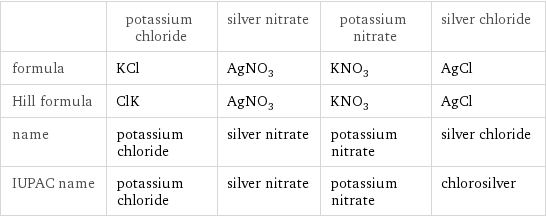
| potassium chloride | silver nitrate | potassium nitrate | silver chloride formula | KCl | AgNO_3 | KNO_3 | AgCl Hill formula | ClK | AgNO_3 | KNO_3 | AgCl name | potassium chloride | silver nitrate | potassium nitrate | silver chloride IUPAC name | potassium chloride | silver nitrate | potassium nitrate | chlorosilver
Substance properties

| potassium chloride | silver nitrate | potassium nitrate | silver chloride molar mass | 74.55 g/mol | 169.87 g/mol | 101.1 g/mol | 143.32 g/mol phase | solid (at STP) | solid (at STP) | solid (at STP) | solid (at STP) melting point | 770 °C | 212 °C | 334 °C | 455 °C boiling point | 1420 °C | | | 1554 °C density | 1.98 g/cm^3 | | | 5.56 g/cm^3 solubility in water | soluble | soluble | soluble | odor | odorless | odorless | odorless |
Units
